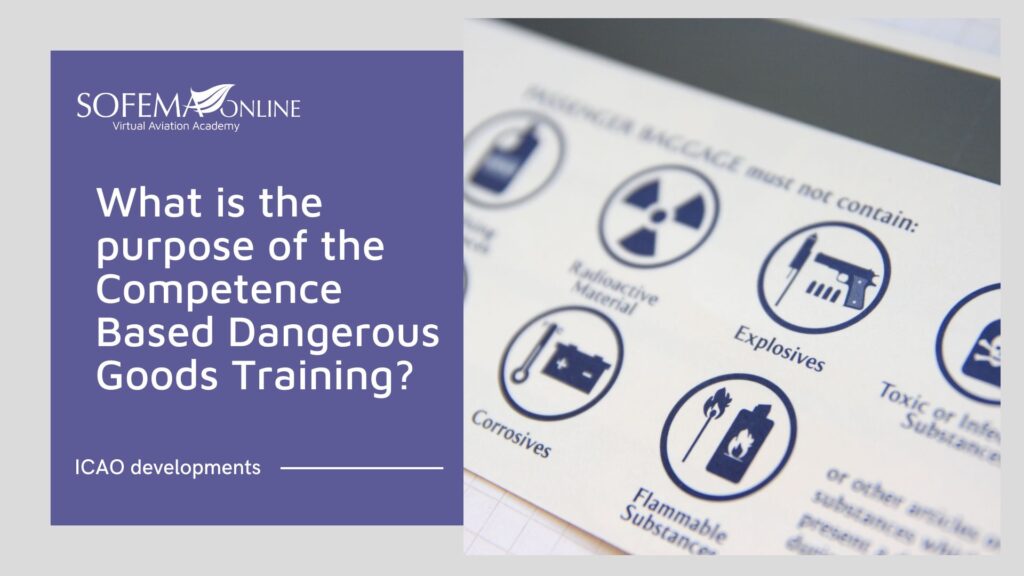Sofema Online (SOL) www.sofemaonline.com looks at the ongoing implementation of Competence-Based Aviation Dangerous Goods Training and introduces our New Competency-Based Dangerous Goods courses.
Introduction
CB-DGR TRAINING is a significant step forward in ensuring the safe handling of dangerous goods by air. While it may present some challenges, the advantages of the approach outweigh the challenges and make it a worthwhile investment for any organization involved in the transportation of dangerous goods by air.
Competence-based dangerous goods training programs should include training on the proper use of equipment, hazard communication, emergency response procedures, and the recognition of dangerous goods. They should also include assessment methods to evaluate the effectiveness of the training and to ensure that personnel has developed the necessary competencies to perform their job safely and effectively.
The International Civil Aviation Organization (ICAO) introduced the Competence-Based Aviation Dangerous Goods Training (CB-DGR Training) to improve the safety of air transportation by ensuring that those involved in the handling, transporting, and shipping of dangerous goods by air have the necessary knowledge, skills, and attitudes to perform their duties safely and effectively.
Considering a Different Approach to Competence-Based DGR Training
- The CB-DGR Training approach focuses on the assessment of a candidate’s competence rather than simply checking whether they have attended a training program or passed an exam. It aims to ensure that personnel handling dangerous goods are equipped with the necessary knowledge and practical skills to perform their duties safely and in compliance with regulations.
Advantages of CB-DGR TRAINING include:
- Improved safety: The CB-DGR TRAINING approach ensures that those handling dangerous goods have the necessary knowledge and skills to do so safely, reducing the risk of accidents and incidents.
- Standardization: The CB-DGR TRAINING approach provides a standardized approach to training and assessing competence, ensuring that all personnel involved in handling dangerous goods by air are trained to the same high standard.
- Flexibility: The CB-DGR TRAINING approach allows for training to be tailored to the specific needs of the individual or organization, providing flexibility in training delivery and assessment.
- Continuous improvement: The CB-DGR TRAINING approach promotes continuous improvement through ongoing assessment and feedback, ensuring that personnel maintains their competence throughout their career.
What are the primary challenges of CB-DGR TRAINING?
- Implementation: Implementing CB-DGR TRAINING can be a complex and time-consuming process, requiring significant resources and commitment from both the training provider and the organization.
- Assessment: Assessing competence can be a subjective process, and it may be challenging to ensure consistency in assessment across different assessors.
- Cost: CB-DGR TRAINING may be more expensive than traditional training approaches, as it requires ongoing assessment and feedback to maintain competence.
- Resistance to change: Some individuals or organizations may be resistant to change and may prefer traditional training approaches.
Measuring the Effectiveness of Competence-Based DGR Training
The effectiveness of ICAO Competence Based Aviation Dangerous Goods Training can be measured by considering various factors, such as the following:
- Knowledge retention: Conduct assessments or evaluations to test the retention of knowledge acquired by the trainees during the training. This could be done through tests or quizzes.
- Compliance: Monitor the number of violations of dangerous goods regulations after the training. If there is a reduction in the number of violations, this indicates that the training was effective.
- Incident rate: Measure the rate of incidents related to dangerous goods before and after the training. If there is a reduction in the number of incidents after the training, this indicates that the training was effective.
Presenting SOL Competency-Based Dangerous Goods courses
Our training courses were developed according to the recommendations of the IATA Dangerous Goods Training Guidance 2023 for competency-based training and assessment:
- Competency Based DG Training – Personnel Responsible for Handling in a Warehouse, Load and Unload
- Competency Based DG Training – Flight Operations Officers and Flight Dispatchers
- Competency Based DG Training – Personnel Responsible for Accepting Passenger and Crew Baggage
- Competency Based DG Training – Processing or Accepting Goods Presented as General Cargo
- Competency Based DG Training – Cabin Crew
- Competency Based DG Training – Flight Crew
- Competency Based DG Training – Personnel Responsible for the Planning of Aircraft Loading
- Competency Based DG Training – Screening of Passengers and Crew and their Baggage, Cargo, and Mail
Follow each link to view the course content and to Sign up directly!
For any questions, contact team@sassofia.com
Tags:
ICAO, Dangerous Goods, Online courses, SOL Training, International Civil Aviation Organisation (ICAO), Aviation Dangerous Goods Training, Competence-Based Aviation Dangerous Goods Training, Competence-Based Aviation Dangerous Goods Courses, Flight operations officer, Flight Dispatcher, Cabin Crew Dangerous Goods, Flight Crew Dangerous Goods




